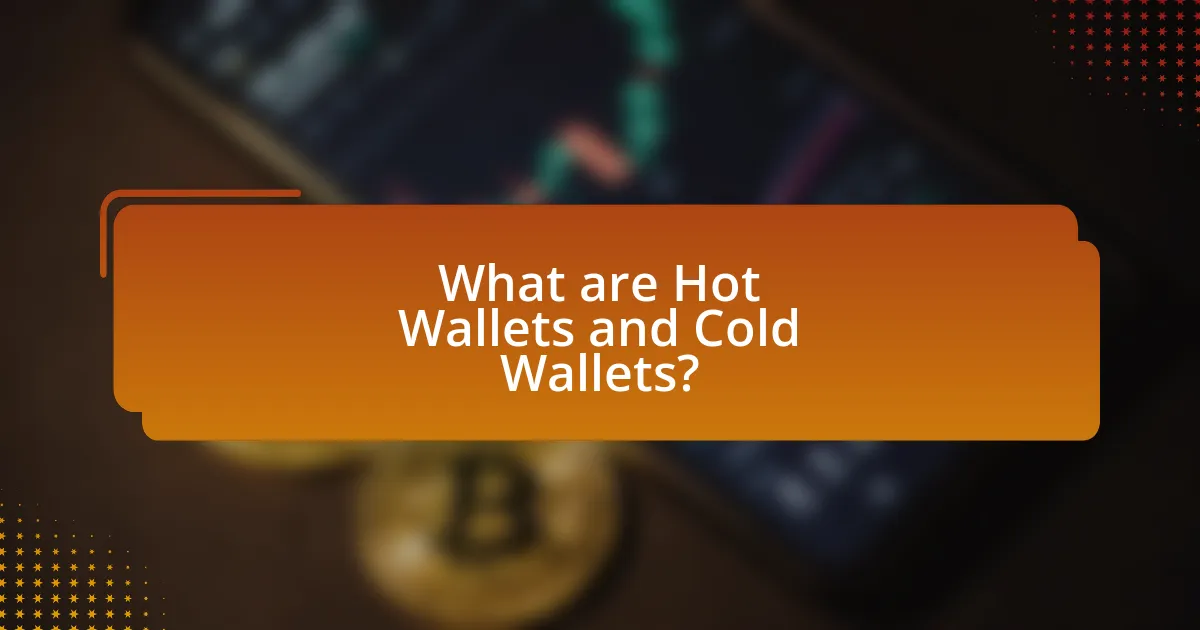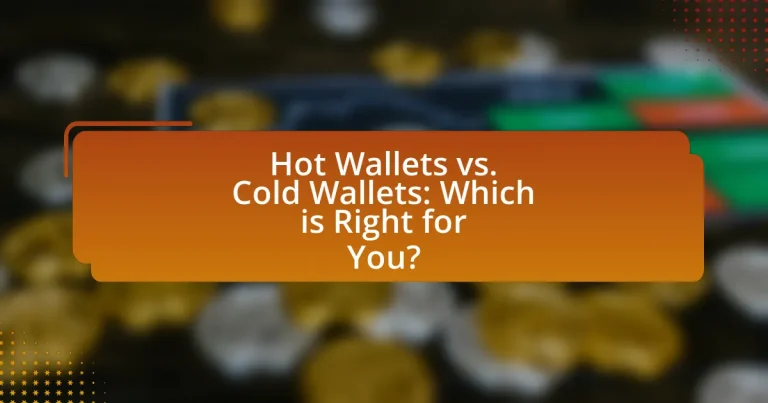Hot wallets and cold wallets are two primary types of digital wallets used for storing cryptocurrencies, each with distinct features and security implications. Hot wallets are internet-connected, offering convenience for frequent transactions but posing higher risks of hacking and theft. In contrast, cold wallets provide offline storage, enhancing security for long-term asset management but sacrificing immediate accessibility. This article explores the differences between hot and cold wallets, their respective advantages and disadvantages, security risks, and best practices for users to effectively manage their cryptocurrency holdings based on their transaction habits and security needs.

What are Hot Wallets and Cold Wallets?
Hot wallets are digital wallets that are connected to the internet, allowing for quick and easy access to cryptocurrencies for transactions. They are typically used for everyday trading and spending due to their convenience but are more vulnerable to hacking and theft. Cold wallets, on the other hand, are offline storage solutions that keep cryptocurrencies secure from online threats. They are used for long-term storage and are considered safer because they are not connected to the internet, reducing the risk of unauthorized access. The distinction between hot and cold wallets is crucial for users to manage their cryptocurrency security effectively.
How do Hot Wallets differ from Cold Wallets?
Hot wallets differ from cold wallets primarily in their connectivity to the internet. Hot wallets are online wallets that allow for quick access and transactions, making them convenient for frequent trading. In contrast, cold wallets are offline storage solutions, providing enhanced security by keeping private keys disconnected from the internet, which significantly reduces the risk of hacking. According to a report by the Blockchain Research Institute, cold wallets are considered more secure for long-term storage of cryptocurrencies due to their offline nature, while hot wallets are favored for their ease of use in daily transactions.
What are the key features of Hot Wallets?
Hot wallets are digital wallets that are connected to the internet, allowing for easy access and quick transactions. Key features include user-friendly interfaces, real-time transaction capabilities, and support for multiple cryptocurrencies. Additionally, hot wallets often provide convenience for frequent trading and immediate access to funds, making them suitable for active traders. However, they are more vulnerable to hacking and security breaches compared to cold wallets, which are offline storage solutions. This vulnerability is evidenced by numerous incidents where hot wallets have been compromised, highlighting the importance of security measures for users.
What are the key features of Cold Wallets?
Cold wallets are primarily characterized by their offline storage of cryptocurrencies, which enhances security against hacking and online threats. They typically come in the form of hardware devices or paper wallets, ensuring that private keys are not exposed to the internet. This offline nature significantly reduces the risk of unauthorized access, making cold wallets a preferred choice for long-term storage of digital assets. Additionally, cold wallets often support multiple cryptocurrencies and provide users with a straightforward interface for managing their holdings securely.
Why are Hot Wallets used by cryptocurrency users?
Hot wallets are used by cryptocurrency users primarily for their convenience and accessibility. These wallets allow users to quickly send and receive cryptocurrencies, making them ideal for frequent transactions and trading. According to a report by Chainalysis, over 90% of cryptocurrency transactions occur through hot wallets due to their user-friendly interfaces and real-time access to funds. This ease of use is particularly beneficial for traders who need to react swiftly to market changes.
What advantages do Hot Wallets offer for daily transactions?
Hot wallets provide significant advantages for daily transactions, primarily due to their accessibility and speed. These wallets are connected to the internet, allowing users to quickly send and receive cryptocurrencies without the delays associated with offline storage methods. For instance, transactions can be completed in seconds, making hot wallets ideal for frequent trading or everyday purchases. Additionally, hot wallets often come with user-friendly interfaces and mobile applications, enhancing the overall user experience. This convenience is crucial for individuals who require immediate access to their funds for regular transactions.
What security risks are associated with Hot Wallets?
Hot wallets are associated with several security risks, primarily due to their constant connection to the internet. This connectivity makes them vulnerable to hacking, phishing attacks, and malware, which can lead to unauthorized access and theft of funds. For instance, in 2020, the KuCoin exchange suffered a hack that resulted in the loss of over $280 million worth of cryptocurrencies, highlighting the risks inherent in using hot wallets for storing significant amounts of digital assets. Additionally, users may inadvertently expose their private keys through insecure practices, further increasing the likelihood of theft.
What are the benefits of using Cold Wallets?
Cold wallets provide enhanced security for cryptocurrency storage by keeping private keys offline, significantly reducing the risk of hacking and unauthorized access. This offline nature protects assets from online threats, making cold wallets a preferred choice for long-term storage. Additionally, cold wallets often support a wide range of cryptocurrencies, offering flexibility for users. Their use in secure environments, such as hardware wallets or paper wallets, further ensures that assets remain safe from malware and phishing attacks.
How do Cold Wallets enhance security for long-term storage?
Cold wallets enhance security for long-term storage by keeping private keys offline, thereby reducing exposure to online threats. Unlike hot wallets, which are connected to the internet and vulnerable to hacking, cold wallets store cryptocurrencies on devices that are not connected to any network. This offline storage method significantly mitigates risks such as malware attacks and unauthorized access. For instance, hardware wallets, a type of cold wallet, utilize secure elements to protect private keys, making it nearly impossible for hackers to access the funds without physical possession of the device.
What types of Cold Wallets are available?
There are two main types of cold wallets available: hardware wallets and paper wallets. Hardware wallets are physical devices that securely store private keys offline, making them less vulnerable to hacking; examples include Ledger and Trezor. Paper wallets involve printing the private keys and public addresses on paper, which can be stored securely but require careful handling to avoid loss or damage. Both types provide enhanced security for cryptocurrency storage compared to hot wallets.

What factors should you consider when choosing between Hot and Cold Wallets?
When choosing between Hot and Cold Wallets, consider security, accessibility, and usage frequency. Hot wallets, which are connected to the internet, offer greater accessibility for frequent transactions but are more vulnerable to hacks, as evidenced by the 2019 Binance hack where $40 million was stolen from a hot wallet. In contrast, cold wallets, which are offline, provide enhanced security for long-term storage but are less convenient for quick access. Therefore, the decision hinges on balancing the need for security against the need for ease of use based on your transaction habits.
How do your cryptocurrency usage habits influence your choice?
Cryptocurrency usage habits significantly influence the choice between hot wallets and cold wallets. Individuals who frequently trade or use cryptocurrencies for daily transactions tend to prefer hot wallets due to their convenience and quick access. In contrast, users who prioritize security and hold their assets for the long term often opt for cold wallets, which provide enhanced protection against hacking and theft. For example, a study by the Cambridge Centre for Alternative Finance indicates that 45% of cryptocurrency users utilize hot wallets for active trading, while 30% prefer cold storage for long-term holding, highlighting the correlation between usage habits and wallet choice.
What is the frequency of your transactions?
The frequency of transactions in hot wallets is typically high, as they are designed for frequent access and quick trades. Hot wallets are connected to the internet, allowing users to execute multiple transactions daily, often in response to market fluctuations. In contrast, cold wallets are used less frequently, primarily for long-term storage, resulting in a significantly lower transaction frequency. This distinction is crucial for users to consider when choosing between hot and cold wallets based on their trading habits and security needs.
How much cryptocurrency do you plan to store?
The amount of cryptocurrency planned for storage varies based on individual investment strategies and risk tolerance. For instance, a conservative investor may choose to store a smaller amount, such as 1 to 5 Bitcoin, while a more aggressive investor might store larger amounts, potentially exceeding 10 Bitcoin. This variability is supported by data indicating that the average cryptocurrency holder has around 0.5 to 1 Bitcoin, reflecting a cautious approach to investment.
What security measures should you prioritize?
Prioritize multi-factor authentication (MFA) and strong encryption for securing hot wallets. MFA adds an extra layer of security by requiring multiple forms of verification, significantly reducing the risk of unauthorized access. Strong encryption protects sensitive data stored in hot wallets, ensuring that even if a breach occurs, the information remains unreadable. According to a 2021 report by Cybersecurity Ventures, implementing MFA can prevent 99.9% of account hacks, underscoring its effectiveness as a security measure.
How do you assess the security features of each wallet type?
To assess the security features of each wallet type, one must evaluate the inherent characteristics of hot wallets and cold wallets. Hot wallets, which are connected to the internet, typically offer convenience but are more vulnerable to hacking and phishing attacks, as evidenced by the 2019 Binance hack where $40 million was stolen from a hot wallet. In contrast, cold wallets, which store cryptocurrencies offline, provide enhanced security against online threats, making them less susceptible to breaches; for instance, hardware wallets like Ledger have not reported any successful hacks since their inception. Therefore, the assessment involves analyzing the trade-off between accessibility and security, with cold wallets generally being the safer option for long-term storage.
What are the best practices for securing your wallet?
The best practices for securing your wallet include using strong, unique passwords, enabling two-factor authentication, and regularly updating wallet software. Strong passwords should consist of a mix of letters, numbers, and symbols, making them difficult to guess. Two-factor authentication adds an extra layer of security by requiring a second form of verification, such as a text message or authentication app. Regular updates to wallet software ensure that any security vulnerabilities are patched, protecting against potential threats. Additionally, users should avoid sharing sensitive information and be cautious of phishing attempts, as these are common tactics used by cybercriminals to gain access to wallets.

What are the common misconceptions about Hot and Cold Wallets?
Common misconceptions about hot and cold wallets include the belief that hot wallets are inherently insecure and that cold wallets are completely immune to risks. While hot wallets, which are connected to the internet, do carry a higher risk of hacking, they also offer convenience for frequent transactions. Conversely, cold wallets, which store cryptocurrencies offline, are not entirely risk-free; they can be lost or damaged, and users may face challenges in accessing their funds if they misplace their recovery information. Understanding these nuances is essential for effective cryptocurrency management.
Why do some users believe Hot Wallets are always unsafe?
Some users believe Hot Wallets are always unsafe due to their constant connection to the internet, which makes them vulnerable to hacking and cyber attacks. This perception is reinforced by numerous incidents where exchanges and wallets have been compromised, resulting in significant financial losses for users. For example, in 2014, the Mt. Gox exchange, which operated a Hot Wallet, was hacked, leading to the loss of approximately 850,000 Bitcoins. Such events contribute to the widespread belief that Hot Wallets lack adequate security measures compared to Cold Wallets, which are offline and less susceptible to online threats.
What evidence supports the safety of Hot Wallets in certain scenarios?
Hot wallets can be safe in certain scenarios, particularly when used for small transactions or day-to-day trading. Evidence supporting their safety includes the fact that hot wallets are often secured with advanced encryption and multi-factor authentication, which significantly reduces the risk of unauthorized access. Additionally, many reputable exchanges and wallet providers implement regular security audits and updates to protect user funds. For instance, a study by the Blockchain Security Alliance found that hot wallets can maintain a high level of security when combined with user education on phishing attacks and secure password practices. This indicates that while hot wallets are inherently more vulnerable than cold wallets, their safety can be enhanced through proper security measures and user vigilance.
How can users mitigate risks associated with Hot Wallets?
Users can mitigate risks associated with Hot Wallets by implementing strong security measures such as enabling two-factor authentication (2FA), using complex passwords, and regularly updating software. Two-factor authentication adds an extra layer of security, making unauthorized access more difficult. Complex passwords reduce the likelihood of successful brute-force attacks, while keeping software updated ensures that users benefit from the latest security patches and features. According to a report by the Cybersecurity & Infrastructure Security Agency, 2FA can prevent 99.9% of automated attacks, highlighting its effectiveness in enhancing security for Hot Wallets.
What myths exist about Cold Wallets being completely foolproof?
Cold wallets are not completely foolproof, as they can still be vulnerable to various risks. One prevalent myth is that cold wallets are immune to hacking; however, while they are offline and less susceptible to online attacks, they can still be compromised through physical theft or user error, such as losing the device or failing to secure the recovery seed. Additionally, another myth is that cold wallets eliminate all risks associated with cryptocurrency storage; in reality, they require careful management and security practices to ensure the safety of the assets stored within them.
What vulnerabilities can Cold Wallets have?
Cold wallets can have vulnerabilities such as physical theft, loss, and damage. These vulnerabilities arise because cold wallets, which store cryptocurrencies offline, can be physically accessed by unauthorized individuals if not securely stored. For instance, if a cold wallet is kept in an easily accessible location, it can be stolen. Additionally, if a user loses the device or it becomes damaged, access to the stored cryptocurrencies can be permanently lost. According to a report by Chainalysis, physical theft of hardware wallets has been a growing concern, highlighting the importance of secure storage practices.
How can users ensure the safety of their Cold Wallets?
Users can ensure the safety of their cold wallets by implementing strong security measures such as using hardware wallets, keeping the wallet firmware updated, and storing the recovery seed in a secure location. Hardware wallets, which are physical devices that store private keys offline, significantly reduce the risk of online hacking. Regular firmware updates help protect against vulnerabilities that could be exploited by attackers. Additionally, storing the recovery seed—a crucial component for wallet recovery—in a safe and secure place, such as a safe deposit box, minimizes the risk of loss or theft. These practices are essential for maintaining the integrity and security of cold wallets.
What are the best practices for managing your cryptocurrency wallets?
The best practices for managing cryptocurrency wallets include using strong, unique passwords, enabling two-factor authentication, regularly updating wallet software, and keeping backups of wallet data in secure locations. Strong passwords protect against unauthorized access, while two-factor authentication adds an extra layer of security. Regular updates ensure that the wallet software is protected against vulnerabilities. Backups are crucial for recovery in case of device loss or failure. According to a report by the Blockchain Security Alliance, 90% of cryptocurrency thefts occur due to poor security practices, highlighting the importance of these measures.


